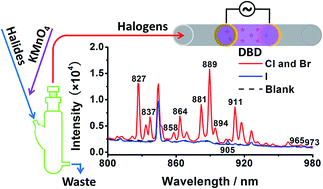Dielectric barrier discharge-optical emission spectrometry for the simultaneous determination of halogens†
Abstract
Dielectric barrier discharge (DBD) micro-plasma as a radiation source has been investigated for the excitation of chlorine, bromine and iodine and their simultaneous determination by vapor generation-DBD optical emission spectrometry (OES). Chloride and bromide in 6 mol L−1 H2SO4 were on-line vaporized by reaction with 0.1 mol L−1 KMnO4, while bromide and iodide in 0.5 mol L−1 H2SO4 were on-line vaporized by reaction with 0.02 mol L−1 KMnO4. The vapor species of halogens were subsequently transferred into a tubular DBD excitation chamber by a helium stream for performing multi-element optical emission and detection with a small charge-coupled device (CCD) spectrometer. Special attention has been paid to the simultaneous vapor generation introduction of halogens and subsequent multi-element DBD optical emission. With the characteristic emission lines of Cl 837 nm, Br 827 nm and I 905 nm as the analytical lines for quantification, the detection limits for the simultaneous determination of Cl and Br were 15 and 11 μg L−1, respectively, while those for Br and I were 10 and 95 μg L−1, respectively. The accuracy of the present DBD-OES system was confirmed by the determination of halide contents in a few certified reference materials and real samples.

- This article is part of the themed collection: 2015 Asia Pacific Winter Conference on Plasma Spectrochemistry, Xiamen, China

 Please wait while we load your content...
Please wait while we load your content...